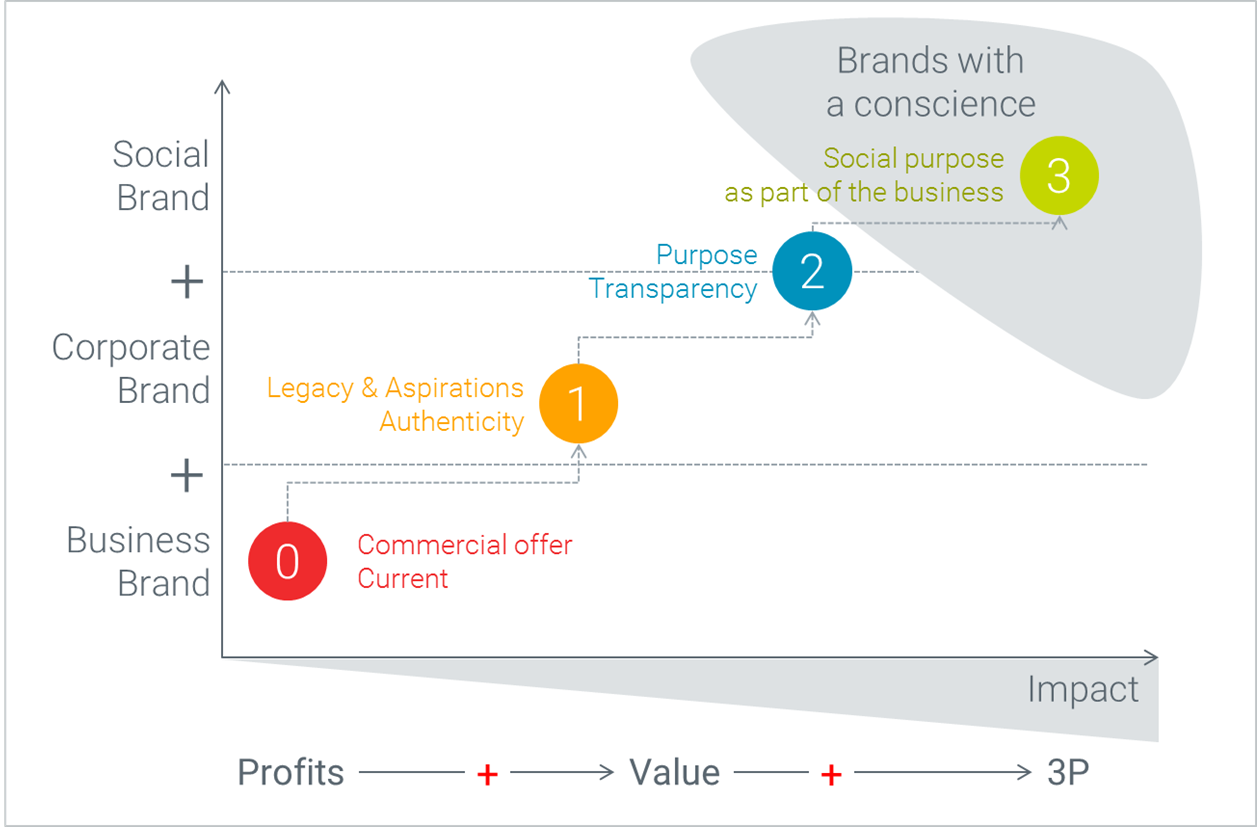…When You Come from the Dark Side
This post is a synthesis of a presentation which took place during the 2017 Medinge Group Spring Meeting in Seville, Spain.
It presents the practical learnings from several years working on building brands with a conscience, with different clients and in different regions around the world.
Why & What
When creating a company with a sense of permanence and transcendence, it’s almost a fact that the first concept to be defined –implicitly or explicitly, is its purpose. Before asking ourselves what we “will do” –the mission, we try to answer “why” we will do this or that –the purpose.
The “why” guides, the “what” drives
Due to different reasons that were outlined in “Branding & Purpose | When Adam & Eve become fashionable“, purpose has returned to the top leaders’ agenda.
When you are starting a new venture, defining and acting according to a purpose is quite simple. The issue is when the company is several years old. Sometimes we have the feeling that at some point we’ve become part of the “Dark Side of the Force”.
If you want you can stay there –it’s up to you, but you may also feel the need and decide to go towards the “Light Side” and “May the Force be with You”.
Actually, over time, two simultaneous things often happen:
- The purpose is diluted. Changes, including generational ones can dilute the purpose, especially if it has not been expressed explicitly. Then mission –what for, and vision –where, dominate. Not so bad, but the purpose then is superficial and can generate unpredictable side effects.
- Purposes evolve with the context. Without changing it a purpose acquires new meanings. As an example:
- Greenpeace purpose is “to change attitudes and behaviour, to protect and conserve the environment and to promote peace”
- In the 1990s this purpose made a large majority see them as dangerous and antisocial people, whilst at the beginning of this century they were recognised as activists and now as key and serious players on environmental improvement
- As with their values, their purpose has remained the same, however, its contents and meanings have evolved over time
- The same thing has happened with our demands of companies, which leads to a process of mutual evolution and adaptation
The Five Learning Keys –up to now
Recreating a purpose not only starts from the company towards its external audiences, but also it’s the result of understanding external demands which drive the evolution of “why” the company exists.
The learning keys are:
- Assimilate what is happening around us
- Understand the starting point
- Explain a re-created purpose
- Design a road map for staging purpose
- Bring purpose to life
1. Assimilate what is happening around us
When talking about our context, the great “topic” that usually arises is Millennials. I say topic because, under traditional patterns they are usually described and generalized as the generation with highest academic training in history, however they are also labelled as poorly bred, hedonistic and lazy, among other things.
Millennials have been born in a state of prosperity that, for the moment, will be hard to reach again.
Seriously speaking, Millennials own certain characteristics that begin to be attractive to other generations:
- They inspire younger people
- Surprisingly, they improve the way life is understood by their predecessors
They have sense of belonging, have the know-how to connect with others, are pragmatic, realistic, conscious, responsible, demanding and above all, they are catalysts of change. Even more important, going back to what I’ve said before, these characteristics are spreading among other generations.
From a company point of view this generation leaves us with certain learnings that we should understand. The first step is to give an answer to:
- How does the trend towards responsible consumption and the acceptance that companies cannot grow indefinitely impact our business? Should we expand and/or re-define our business models?
- Are we aware that different demands of society –from behaviours to products, are just a click away? How can our companies differentiate themselves, how can they show what they are and are doing, how to give answers to new demands…?
- Do we understand that our audiences are intuitively associated with our companies because they share values and are a biographically unique group?
We are in a turbulent, uncertain, complex and ambiguous world where the new generations are establishing new demands which will have to be answered in order to do business –and probably survive (BTW, VUCA has evolved into TUCA World, from Volatile to Turbulent).
In addition and stressing the need of change, certain investors are choosing and recommending companies that are, in addition to profits, generating a positive social and environmental impact –a typical Millennials’ demand.
2. Understand the starting point
Due to different reasons, some companies are more focused on the commercial side while others are dealing with what is known as “3Ps” -people, planet & profits. Most companies are somewhere in the middle.
Companies have a way ahead for them:
- Most new companies are based on a purpose –not necessarily a transcendental one, but one which should grow and maintain relevance
- Those companies which need to recreate their purpose have to ensure they are on the path of building long-lasting value
In terms of the brand that must accompany and synthesize this evolution, companies can be in different stages and each of them has dissimilar types of requirements, and therefore, they have to develop tailored actions for each particular situation.
Understanding the starting point allows to know where the journey begins and how long it will take.
Organisations can only assimilate changes that generate a state of creative tension meaning that they are unable to skip any step if they want to build a purpose –e.g.: if the company is in stage 1 it cannot jump directly to step 3. If it finally goes beyond their real competencies, the result would be the opposite of what is expected, generating a high level of frustration. This statement is fundamental to understand what’s next.
3. Explain a re-created purpose
Once the contextual requirements, audiences and a starting point have been defined, understood and assimilated by the organisation, the company would be in a condition to re-create its purpose.
Such purpose should have at least three major characteristics:
- It must respond explicitly to why the company exists. For example at Allegro 234 we invite our clients’ top management team to undertake a synthesis exercise in which they express an idea in a 15 words sentence –in fact 15 or less!
- Although it is complex, the result must be a simple statement. Arriving at a meaningful and fundamental concept for the existence and transcendence of the company is a unique event whose importance lies in that the organization and external audiences understand, assimilate and live it. Hence the purpose must have a simple, memorable, understandable and replicable syntax. The purpose should be what it is without requiring any further explanation.
- Besides realism, the purpose should provide focus, supporting what the company does. E.g.: The purpose of Tony’s Chocolonely –the leading chocolate company in the Netherlands, is: “Together we make 100% slave free the norm in chocolate”. All their actions respond to this purpose and only to this purpose. And as business its revenues are growing at a rate above 40% ACGR (2009-2014)
Thus defined, a transcendent purpose is an umbrella of mission, vision, culture and positioning, subsuming CSR and environmental actions into the business –going beyond a series of indicators that are increasingly questioned, day in, day out. It’s not only to say it, it is also to build and live it!
In terms of business, the purpose is the highest level independent strategic variable that guides all company actions.
Finally, the purpose has to be validated ensuring its alignment with current definitions of mission, vision and positioning. This entails two way adjustments in which, although the purpose will have right of precedence, all strategic definitions must be internally coherent. Fundamentally, this is a top level process.
4. Design a road map for staging purpose
In developing the roadmap, what matters are the milestones beyond the path that one wishes to follow. This is because it’s a medium/long term process and what today may be the right way, next year could require adjustments of premises and/or plans. The building model behind it is the ABCDETM –Anticipation, Blend, Creation, Distillation and Execution.
The objective of the construction of this “master plan” –a good name if you want to give it more weight, is to link up the different activities that the organization develops and connect to the purpose –in the same way, eliminate actions that cannot find an appropriate justification. This implies:
- Define the key events that will be milestones of the master plan
- Define satisfaction and measurement policies, and the goals pursued by the plan
The principles ensuring the success of this step are in what is known as “crafted brand strategy“:
- It merges formulation and implementation into a fluid process through which creative concepts, actions and activities evolve
- It is done in a way where craft evokes traditional skill, dedication, perfection through the mastery of detail, looking for a transcendent cultural significance
The difference from the traditional processes is that this approach is based on a co-creative process with internal intentionality, but that is built from outside to inside.
5. Bring purpose to life
Finally, the purpose must be brought to life and here the important thing is not to go out and tell it. Rather it is to make it evident through the actions –which will be later communicated.
It’s story-building rather than storytelling -concept developed by Philippe Mihailovich.
Instead of being limited to the story, the organisation should actively reshape the role of companies in society because it allows the convergence of interests between stakeholders and society, responds to the demands of an interconnected society and ensures a positive return that makes the business lasting in the long-term.
The staging explains the actions that will be implemented as first steps toward what is known as a social brand, while coordinating businesses, areas, regions and suppliers, ensuring that when clarity of purpose is provided, it:
- Is an agent of change
- Reduces risk
- Increases relevance
In summary
Companies –including yours, are expected to have a new role in society in order to respond to new demands.
Realistically, fulfilling this new role implies ensuring social, environmental and economic results. The balance among these three concepts will be adjusted according to each company, sector and geography.
If there is not enough conviction to change behaviour, at least the company should recognize the rewards of changing certain attitudes –yet, still there is a lack of real conscious leadership. It is an opportunity that some companies, from bottom up, have assumed. For example, the most reputable US companies (compared against the S&P500) are larger and grow faster –although, not all reputable companies necessarily have a credible purpose.
Finally bring the purpose to life and the brand ends up synthesizing all key audiences towards and between people, organization and society.
Brands with a conscience promote a particular way of understanding the world and contributing to its social transformation.






2 comments
Join the conversationJack Yan - Mar 24, 2018
Excellent piece, Cristián—incredibly well thought out and practical, too.
Cristián Saracco - Apr 25, 2018
Thank you very much Jack! 🙂